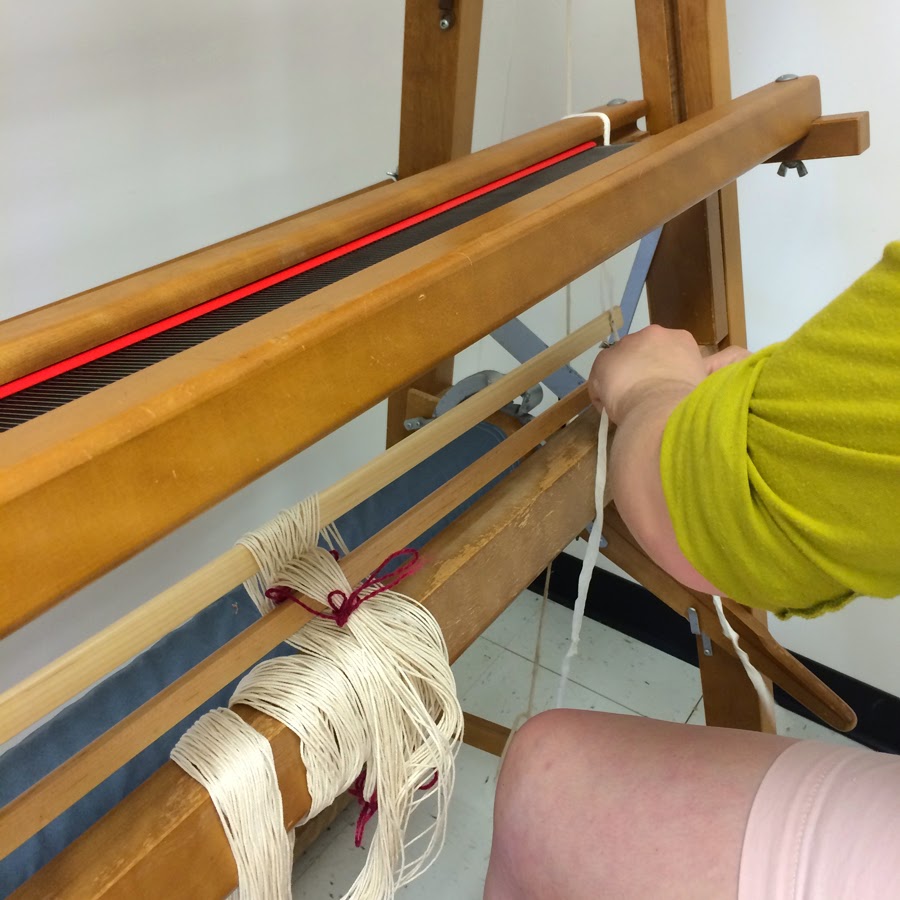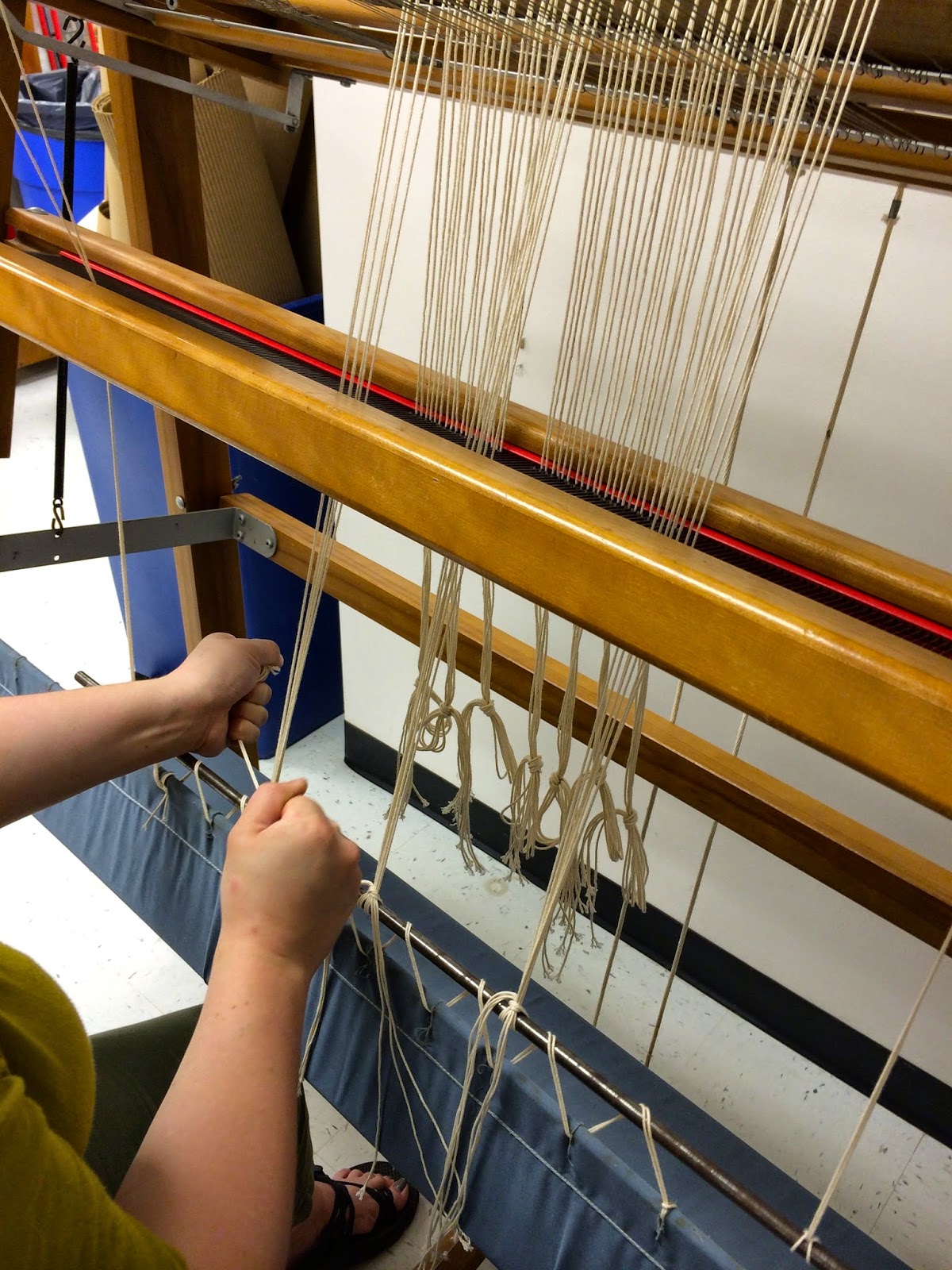I'm posting this step-by-step description for one of the ways I've used for the Tissart tapestry loom.
By the way, the Tissart loom is no longer manufactured by Leclerc Looms but they sometimes are to be found through resale of used looms.
I've used this method with other upright tapestry looms, as well. If you weave on floor looms you'll recognize that this is a variation of what's called "front to back" warping where the reed is sleyed, the heddles threaded, and then the warp beamed. I've also used a "back to front" process for warping the upright tapestry looms in which either I use the reed to rough sley the warp and then beam, or use a raddle to space the warp as it's beamed.
Feel free to use and adapt as best fits your needs. Please, if you use these instructions specifically, note the source!
Threading
the Tissart Tapestry Loom
Instructions
developed by Tommye McClure Scanlin
I’ve had a
Tissart loom since 1988 and have warped it many times using several methods,
including the instructions that came with the loom. I’ve found this method to be a good one. Of course, it isn’t the only way one can
proceed—whatever works for someone is the “best” way!
The instructions below describe sleying the reed, followed by
threading the heddles and tying on the ends to the apron rod on the warp
beam. The warp is then beamed and next
tied on at the front apron rod for the final tensioning. When beaming, I use either flat lattice
strips between layers or roll corrugated cardboard wound between each
revolution of the warp beam.
1. Make warp chain(s) and
put in a tie at the cross. I usually
have no more than about 100 warp ends per chain so the bundles will be small
enough to easily tension when beaming.
2. Unhook the beater from
the springs holding up it at the sides.
This allows the bottom part of the beater to rest on the breast
beam. Put the correct dent reed into the
beater.
3. Sit comfortably and have
a good light nearby. Before beginning to
sley, loosely wind the warp chains around the breast beam (or, alternatively,
sit on them) so the warp won’t slip too far forward when pulling ends through
the dents.
 |
| Leah's holding the cross for sleying in this photo. The warp chain is wrapped a couple of times around the lower beam to hold it secure as the sleying takes place. |
Allow about 20” from the
point where the cross is placed and the end of the warp that is pointed toward
the reed and heddles. I hold the cross
in my fingers, since I make each warp group fairly small, but one can also place
the cross sticks into the warp cross and sleyed from those. If using cross sticks be sure they’re tied
together about 1” apart and also tied to the loom so they won’t slip out on one
side or the other. Just do which ever seems most comfortable for you and then
proceed to sley the reed.
 |
| If you'd rather use cross sticks, slip them in place... |
 |
| then secure them at top and bottom so they're about 1" apart. |
 |
Leah's measuring from center to right to begin sleying.
|
 |
| Sleying begins. |
 |
| After sleying, tie groups in slip knots as a security measure while getting ready for the next steps... don't want any warps to fall out! |
4. After sleying, re-hook
the springs to the beater assembly so the reed with sleyed warp in place is
higher and nearer the heddles.
5. Releasing the warp beam
brake, bring the warp beam bar or rod up and over the top beam
toward the front of the loom, placing it to hang within about 6-8” from the top
of the heddles. Make sure the rod
lashed to the apron rod is straight and horizontal. You'll want the ends of the warp to be long enough to reach a couple of inches above the bar:
 |
Leah makes sure the warp extends long enough to be tied to the warp beam bar.
|
6. Move half the number of
heddles needed for the warp to the center and begin threading (I’m right handed
and move from the right side to the left so half heddle group is pushed to the
center right).
 |
| Leah's counting and moving heddles to the center. |
Moving from right to left
I pick up each warp from its place in the reed, thread it, and then tie it with
a good, firm knot onto the warp apron rod that is hanging over the top
beam. This process continues until all
warp ends are both threaded and tied on. *
At this point, the loose wrapping of warp chain around the breast beam
may have to be loosened a bit to extend the warp ends long enough to tie on at
the warp beam rod. However, I still keep
the warp under some tension so the ends won’t be pulling forward too much while
tying them to the warp beam rod. This
sounds tedious but actually isn’t!
*Alternatively, one can
thread 1” worth of ends and then make a firm overhand knot with those. Tie this knot around the warp apron rod as a
group.
 |
| Tying on in 1" groups (the first couple at the right are tied individually) |
 |
| Leah decided she preferred to tie on individual ends as they were threaded rather than the 1" groups. |
7. To beam, unwrap the
warp, shake it out each bundle, pull/ping, etc.
Turn the warp beam handle to roll until the rod is back over the top
beam and attached to the warp beam, then stop and pull down on each group of
the warp firmly. When the rod begins to
roll onto the warp beam insert corrugated roll paper or the first of lattice
strips. I usually set up a rhythm of
turning the warp beam handle to roll up a complete revolution, then go to the
front to pull down firmly at each warp bunch, shaking and pinging if necessary
to loosen any tangling.
8. If using lattice strips
for most of the warp, after starting the warp with a few inches of corrugated
paper, I then wind with molding or lattice strips, about four to eight per
turn. I usually lay the stick on top of
the warp beam, hold it with one hand while turning the crank with the other until
it’s secured with the warp. It’s a bit
tricky to wind on by yourself using wood strips but can be done.
 |
| Leah's adding corrugated paper to the warp beam. |
9. The beaming is completed
when the warp ends are about even with the lower beam.
 |
| The bar attached to the cloth beam is held up by temporarily tying it onto the loom (the warp ends are tied with slip knots to keep them out of the way until ready to tie onto the bar). |
10. To tie onto the front
apron rod, take 1” groups, splitting these in half to wrap around the
rod and tie with a half-knot. For
instance, if using 8 epi, then 8 ends are in each group tied on. I begin tying with the center-most group,
then a group on the extreme side, then the group on the opposite side. These initial three ties will hold the tie-on
rod up. Going back to the center, tie a
group immediately to the left or right of that first tie. Then, work alternately from the center group
out to either side, to tie on all groups with half-knots.
11. When all bouts are tied
with half-knot then go back to the middle, pull both tails up toward the
reed firmly and complete with a slip knot or a bow knot. Next, move alternately from the middle to
either side, pulling and tightening and comparing, by feel, to the previously
tied group. I pull firmly when tying on
but before beginning to weave I tighten to the weaving tension (quite tight)
with the forward take-up motion lever that hangs from the front cloth beam. You may want to put band-aids on your
fingers before beginning the tensioning step since you’ll probably rub blisters
on your fingers if you don’t!
 |
| Leah checks the tension of the warp after she's tied it on and made the final bow of the knot. |
12. After tying on I weave
in lattice strips (or in the photo example, strips of plastic blinds) in alternating sheds to advance the tie-on
rod all the way to the cloth beam. I like to get the rod to the cloth beam before beginning the "good" part of the weaving. I've found that this will give a good, firm base on which to begin. Yes, it's more loom waste but if you're going to working on a piece for weeks or months, don't you want the advantage of the best possible start?!
 |
| Looking into the loom to see the tie-on bar has now wound down to the cloth beam. |
I
beat these with the beater, beating after each shed change. When the rod and tie-on knots touch the cloth
beam I weave in about 1-2” of scrap yarn at the top of the strips, beating
with the beater firmly. Finally,
before beginning the “good” part of the weaving, I weave a header of about ½”
using the same twine the warp is made of. This
should spread the sett of the warp to exactly what you want. Once all that’s in place, double check for
the warp spacing and the weaving is ready to begin. **
**If using half-hitches to
secure the ends do this now.
The photos of the process are of one of the weaving students at the University of North Georgia--thanks for being the model and craftsperson, Leah!































